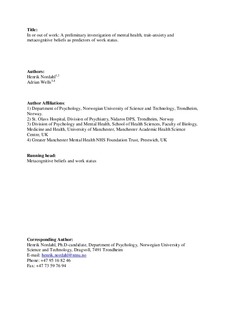| dc.contributor.author | Nordahl, Henrik | |
| dc.contributor.author | Wells, Adrian | |
| dc.date.accessioned | 2019-03-13T08:25:47Z | |
| dc.date.available | 2019-03-13T08:25:47Z | |
| dc.date.created | 2018-05-11T18:36:02Z | |
| dc.date.issued | 2018 | |
| dc.identifier.citation | Clinical Psychologist. 2018, . | nb_NO |
| dc.identifier.issn | 1328-4207 | |
| dc.identifier.uri | http://hdl.handle.net/11250/2589784 | |
| dc.description.abstract | Background
Common mental disorders are associated with significant economic, social, and personal costs that are primarily incurred through loss of work status. Psychological interventions based on cognitive‐behavioural therapy have been implemented to enhance return to work (RTW), but have not proved sufficiently successful. According to the metacognitive model of psychological disorders, metacognitive beliefs are the key factors underlying self‐regulation and could therefore potentially be important for work status. The aim of the current study was therefore to investigate whether metacognitive beliefs could have predictive utility for work status.
Method
In a cross‐sectional design, 427 working age individuals reporting to be working (n = 292) or receiving disability benefits (n = 135) participated in the study.
Results
We found that metacognitive beliefs about the need for mental control were significant as predictors of work status over and above the presence of a diagnosed mental disorder and levels of trait anxiety.
Conclusions
These findings imply that metacognitive beliefs have predictive utility for work status even when controlling for mental health status, and that metacognitive beliefs might therefore be addressed in treatment to enhance RTW and with the aim of reducing long‐term sick leave. | nb_NO |
| dc.language.iso | eng | nb_NO |
| dc.publisher | Wiley | nb_NO |
| dc.title | In or out of work: A preliminary investigation of mental health, trait anxiety and metacognitive beliefs as predictors of work status | nb_NO |
| dc.title.alternative | In or out of work: A preliminary investigation of mental health, trait anxiety and metacognitive beliefs as predictors of work status | nb_NO |
| dc.type | Journal article | nb_NO |
| dc.type | Peer reviewed | nb_NO |
| dc.description.version | acceptedVersion | nb_NO |
| dc.source.pagenumber | 6 | nb_NO |
| dc.source.journal | Clinical Psychologist | nb_NO |
| dc.identifier.doi | 10.1111/cp.12153 | |
| dc.identifier.cristin | 1584654 | |
| dc.description.localcode | Locked until 9.5.2019 due to copyright restrictions. This is the peer reviewed version of an article, which has been published in final form at https://doi.org/10.1111/cp.12153. This article may be used for non-commercial purposes in accordance with Wiley Terms and Conditions for Self-Archiving. | nb_NO |
| cristin.unitcode | 194,67,40,0 | |
| cristin.unitname | Institutt for psykologi | |
| cristin.ispublished | true | |
| cristin.fulltext | original | |
| cristin.qualitycode | 1 | |
